Perform operations on database object nodes
Last modified: July 8, 2025
Database Explorer allows you to create database objects and view, export, import, or filter data using the shortcut menu of the database object nodes.
Tables node
In Database Explorer, right-click the Tables node and select the required command from the shortcut menu.
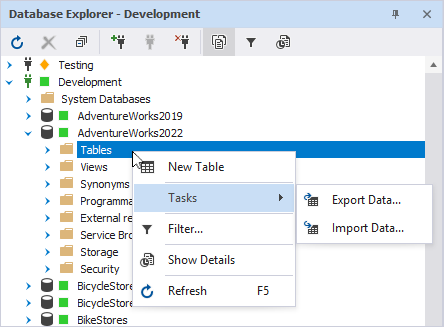
Create a table
To create a table:
1. In Database Explorer, right-click the Tables node and select New Table.
2. In the Table Editor that opens, specify the table name, schema it belongs to, columns and their properties, and data. You can also add triggers or indexes and preview the generated script before saving the table.
For more information about settings you can enter to create a table, see How to work with Table Editor.
3. On the Table Editor toolbar, select Apply Changes to save the table.
Views node
In Database Explorer, right-click the Views node and select the required command from the shortcut menu.
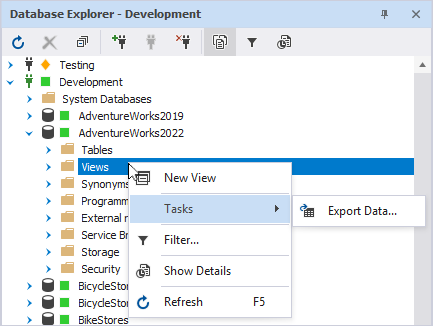
Create a view
To create a view:
1. In Database Explorer, right-click the Views node and select New View.
2. In View Editor that opens, do the following:
- Under Query Text, enter the view name, select the schema it belongs to, enter the query, and select view options.
- Optional: Under Query Design, build the view query on the diagram.
- Optional: Under Indexes, add indexes for the view.
- Optional: Under Statistics, set up statistics.
- Optional: Under Triggers, add triggers.
- Optional: Under T-SQL, preview the generated script.
3. On the View Editor toolbar, select Apply Changes to save the view.
Synonyms node
In Database Explorer, right-click the Synonyms node and select the required command from the shortcut menu.

Create a synonym
To create a synonym:
1. In Database Explorer, right-click the Synonyms node and select New Synonym.
2. In a SQL document that opens, enter the CREATE SYNONYM statement.
3. At the bottom of the SQL document, select Apply Changes to save the synonym.
Procedures node
In Database Explorer, right-click the Procedures node and select the required command from the shortcut menu.
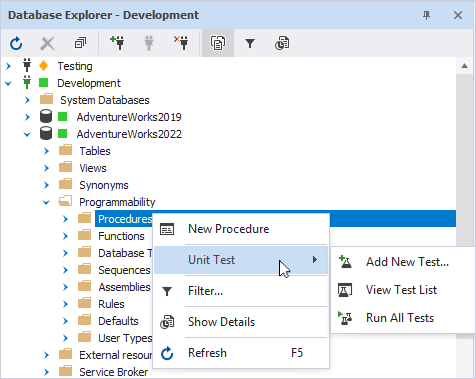
Create a stored procedure
1. In Database Explorer, right-click the Procedures node and select New Procedure.
2. In a SQL document that opens, enter the CREATE PROCEDURE statement.
3. At the bottom of the SQL document, select Apply Changes to save the stored procedure.
Functions node
In Database Explorer, right-click the Functions node and select the required command from the shortcut menu.
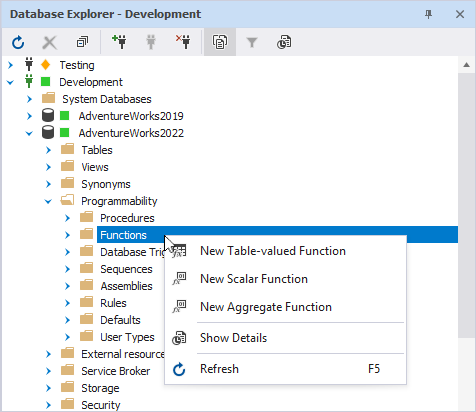
Create a table-valued function
To create a table-valued function:
1. In Database Explorer, right-click the Functions or Table-valued Function node and select New Table-valued Function.
2. In a SQL document that opens, enter the CREATE FUNCTION statement.
3. At the bottom of the SQL document, select Apply Changes to save the function.
Create a scalar function
To create a scalar function:
1. In Database Explorer, right-click the Functions or Scalar Function node and select New Scalar Function.
2. In a SQL document that opens, enter the CREATE FUNCTION statement.
3. At the bottom of the SQL document, select Apply Changes to save the function.
Create an aggregate function
To create an aggregate function:
1. In Database Explorer, right-click the Functions or Aggregate Function node and select New Aggregate Function.
2. In a SQL document that opens, enter the CREATE AGGREGATE statement.
3. At the bottom of the SQL document, select Apply Changes to save the function.
Database Triggers node
In Database Explorer, right-click the Database Triggers node and select the required command from the shortcut menu.
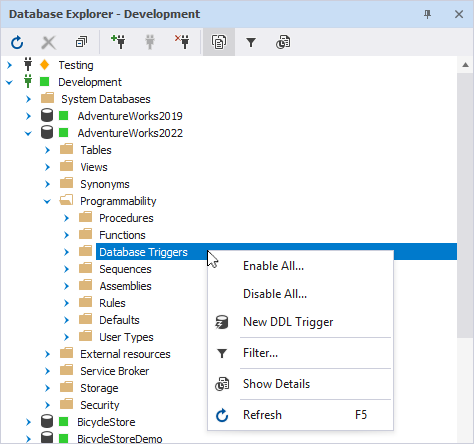
Create a DDL trigger
To create a trigger:
1. In Database Explorer, right-click the Database Triggers node and select New DDL Trigger.
2. In a SQL document that opens, enter the CREATE TRIGGER statement.
3. At the bottom of the SQL document, select Apply Changes to save the trigger.
Enable all triggers
To enable all triggers, right-click the Database Triggers node and select Enable All.
Deactivate all triggers
To deactivate all triggers, right-click the Database Triggers node and select Disable All.
Sequences node
In Database Explorer, right-click the Sequences node and select the required command from the shortcut menu.
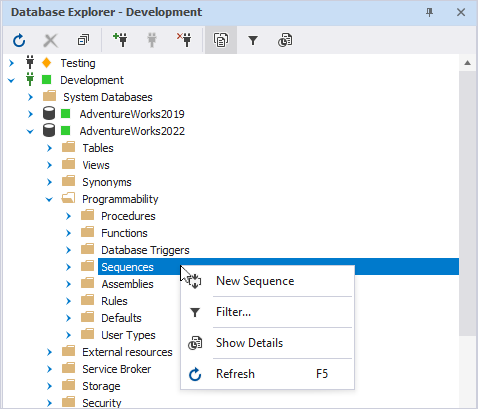
Create a sequence
To create a sequence:
1. In Database Explorer, right-click the Sequences node and select New Sequence.
2. In a SQL document that opens, enter the CREATE SEQUENCE statement.
3. At the bottom of the SQL document, select Apply Changes to save the sequence.
Shortcut menu commands
The following table briefly explains the other shortcut commands available when you right-click an object node in Database Explorer. The table includes each command description and its availability for different database object types.
| Command | Description | Available for database object nodes |
|---|---|---|
| Tasks > Export Data | Opens the Data Export wizard to export data to a file with the supported file extension. | TablesViews |
| Tasks > Import Data | Opens the Data Import wizard to import data from a file into a database. | Tables |
| Filter | Opens the Filter Settings dialog to filter which database objects appear in Database Explorer. | TablesViewsSynonymsProceduresDatabase TriggersSequencesAssemblies (Rules and Defaults)External resourcesService BrokerStorageSecurity |
| Show Details | Opens Object Viewer to view object details. | TablesViewsSynonymsProgrammabilityExternal resourcesService BrokerStorageSecurity |
| Refresh | Updates the database object node to reflect the latest changes made in the database. Alternatively, press F5. | TablesViewsSynonymsProgrammabilityExternal resourcesService BrokerStorageSecurity |
| Unit Test > Add New Test | Opens the Add New Test dialog to create a unit test in the database. | ProgrammabilityProcedures |
| Unit Test > View Test List | Opens the Test List Manager to view unit tests in the database. | ProgrammabilityProcedures |
| Unit Test > Run All Tests | Runs all tests for the selected database. | ProgrammabilityProcedures |
| Find in Security Manager | Opens Security Manager with the highlighted database object. | UsersRolesApplication RolesSchemas |
Want to find out more?
Overview
Take a quick tour to learn all about the key benefits delivered by dbForge Studio for SQL Server.
All features
Get acquainted with the rich features and capabilities of the tool in less than 5 minutes.
Request a demo
If you consider employing this tool for your business, request a demo to see it in action.
- Perform operations on database object nodes
- Tables node
- Create a table
- Views node
- Create a view
- Synonyms node
- Create a synonym
- Procedures node
- Create a stored procedure
- Functions node
- Create a table-valued function
- Create a scalar function
- Create an aggregate function
- Database Triggers node
- Create a DDL trigger
- Enable all triggers
- Deactivate all triggers
- Sequences node
- Create a sequence
- Shortcut menu commands
